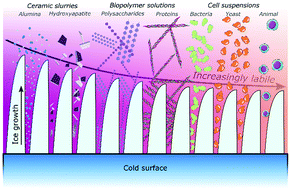Recent advances in ice templating: from biomimetic composites to cell culture scaffolds and tissue engineering
Abstract
Ice templating – or freeze casting – has flourished in multiple domains as a straightforward process to shape solutions and particle suspensions into macroporous materials. Longtime used as a process to shape colloidal suspensions into lightweight ceramics, the use of ice templating has evolved to fabricate materials that mimic the architecture of biological tissues such as nacre and bone. Recently, the technique has been used to shape biopolymers for cell culture systems and tissue engineering applications and eventually to allow the fabrication of biomaterials containing living cells. Here we review how ice templating has progressed to cope with intrinsically labile biological matter and how these advances may shape the future 3D cell culture, tissue engineering and ultimately, cryobiology.



 Please wait while we load your content...
Please wait while we load your content...